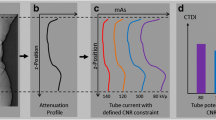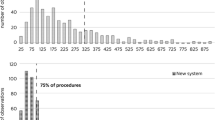Abstract
In this article, we review automatic brightness control (ABC) for fluoroscopy imaging systems. Starting from the simple manual control, the discussion is extended to the kV-primary ABC system, and then to the most recent contrast-to-noise ratio optimized (CNR Optimized) automatic dose rate control system (ADRC). The nature of this review article is trifold. First, it describes the ABC/ADRC and associated circuits governing the operation of the fluoroscopy imaging chain. Second, we show the characteristics of a control logic from a radiation physics point of view. Third, we introduce the most recent activities in the evaluation of CNR-optimized fluoroscopy systems and the phantom design that would be compatible with the design concept of the ADRC. Because of these three subject items in the discussion process, this article is also educational in nature written for medical physicists and radiological technologists who might be less familiar with the design concept of fluoroscopy operation, specifically on the ABC and ADRC. We insert a few related matters associated with fluoroscopy automatic control circuits where they seem applicable and appropriate to enhance the understanding of fluoroscopy operation logic.













Similar content being viewed by others
Abbreviations
- AI:
-
Artificial intelligence
- ABC:
-
Automatic brightness control
- ADRC:
-
Automatic dose rate control
- AEC:
-
Automatic exposure control
- AGC:
-
Automatic gain control
- CCTV:
-
Closed circuit television
- CNR:
-
Contrast-to-noise ratio
- CNROF:
-
Contrast-to-noise ratio optimized fluoroscopy
- FPIRIDR:
-
Flat panel image receptor input dose rate
- FOV:
-
Field-of-view
- FGI:
-
Fluoroscopy guided interventional (angiography)
- FPIR:
-
Flat panel image receptor
- FPIDR:
-
Flat panel input dose rate
- FPIRDR:
-
Flat panel image receptor dose rate
- HLC:
-
High level control
- IEC:
-
International electrotechnical commission
- I I:
-
Image intensifier, image intensified
- IRIDR:
-
Image receptor input dose rate
- mgI/cc:
-
Milligram(s) of iodine per cubic centimeter
- mmAl:
-
Millimeter(s) of aluminum
- mmCu:
-
Millimeter(s) of copper
- PEDR:
-
Patient entrance dose rate
- PERP:
-
Patient exposure reference point
- PET:
-
Patient equivalent thickness
- PIDR:
-
PMMA input dose rate
- PMMA:
-
Polymethyl methacrylate
- pps:
-
Pulses per second
- PW:
-
Pulse width
- ROI:
-
Region of interest
- SDDA :
-
Source-to-detector A
- SDDB :
-
Source-to-detector B
- SID:
-
Source-to-image receptor distance
References
Schueler BA. General overview of fluoroscopic imaging, The AAPM/RSNA Physics Tutorial for Residents. Radiographics. 2000. https://doi.org/10.1148/radiographics.20.4.g00jl301115 (Accessed 4 Oct 2021).
Nickoloff EL. Survey of modern fluoroscopy imaging: flat-panel detectors versus image intensifiers and more. Radiographics. 2011;31:591–602. https://doi.org/10.1148/rg.312105185 (Accessed 4 Oct 2021).
Lin PP. Technical advances of fluoroscopy with special interests in automatic dose rate control (ADRC) logic of cerdiovascular angiography systems. Presented at The Midwest Chapter of AAPM Meeting, November, 2007. https://slideplayer.com/slide/1379353/, Accessed 4 Oct 2021.
Bushberg JT, Seibert JA, Leidholdt EM Jr, Boone JM. The essential physics of medical imaging. 4th ed. Wolters Kluwer publisher; 2020.
Bezak E, Beddoe A, Marcu LG, Ebert M, Price R. Johns and Cunningham’s The Physics of Radiology. 5th ed. Springfield Illinois, USA: Charles C. Thomas Publisher Ltd; 2021.
Lin P-JP, Rauch P, Balter S, Fukuda A, Goode A, Hartwell G, LaFrance T, Nickoloff E, Shepard J, Strauss K. Functionality and operation of fluoroscopic automatic brightness control/automatic dose rate control logic in modern cardiovascular and interventional angiography systems. AAPM Report No. 125, 2012.
Lin P-JP. Cine and photospot cameras. In: Encyclopedia of medical devices and instrumentation, vol. 2. New York, NY: Wiley Interscience; 1988. p. 681–93.
Title 21, Chapter I, Food and Drug Administration, Department of Health and Human Services, Subchapter J, Radiological Health, Part 1020 “Performance Standards for Ionizing Radiation Emitting Products”. (m) Beam Quality, (1) Half-value layer (HVL).
International Electrotechnical Commission. IEC 60601-2-43:2010+AMD 1:2017+AMD2:2019 CSV, Consolidated Version. Medical electrical equipment – Part 2–43: particular requirements for the basic safety and essential performance of X-ray equipment for interventional procedures. Geneva, Switzerland: International Electrotechnical Commission; 2019.
United States Patent 5,680,435. “X-ray diagnostic apparatus with a filter device.” Johann Seissl, October 21, 1997.
Lin P-JP. The operation logic of automatic dose control of fluoroscopy system in conjunction with spectral filters. Med Phys. 2007;34:3169–72.
Lin P-JP. Operation logic and functionality of automatic dose rate and image quality control of conventional fluoroscopy. Med Phys. 2009;36:1496–1493.
Lin P-JP, Goode A, Corwin F. The contrast-to-noise ratio optimized fluoroscopy operation logic (An Investigation), Poster number: PO-Ge-I-206, 2020 Annual AAPM meeting (Virtual Meeting), July 12, 2020.
Desponds L. New trends in angiographic systems technology. July 4, 2019, ESMPE, Praha, Czech Republic
Gordon CI III, Relihan GF. United States Patent No. 6222907 B1, Image Quality Optimization Using An X-ray Model Based Optimization. April 24, 2001.
Tashenov S. White Paper, OPTIQ a new approach to image quality and dose in minimally invasive procedures (Version 1.0 VE20 online pdf-7666 0620), published by Siemens Healthcare GmbH, 2020.
Desponds L. “AutoRightTM Intelligence Inside”, a white paper, GE HealthCare, 2019.
Werncke T, et al. Impact of a contrast-to-noise ratio driven and material specific exposure control on image quality and radiation exposure in angiography. Phys Med Biol. 2021;66:065020.
High M, Cohen G, Lin P-J, et al. Performance evaluation and quality assurance in digital subtraction angiography. AAPM Report #15, May, 1985.
Goode A, et al. Signal and contrast to noise ratio evaluation of fluoroscopic loops for interventional fluoroscope quality control. JACMP. 2019;20(10):172–80.
Dehairs M, et al. Implemrntation of a spatio-temporal figure of merit for new automatic dose rate control regimes in dynamic x-ray imaging. Phys Med Biol. 2019;64:045001.
Dehairs M, et al. Evaluation of automatic dose rate control for flat panel imaging using a spatial frequency domain figure of merit. Phys Med Biol. 2017;62:6610.
Werncke T, Kemling M, Tashenov S, et al. Comparison of a contrast-to-noise ratio-driven exposure control and a regular detector dose-driven exposure control in abdominal imaging in a clinical angiography system. Med Phys. 2021;48:7641–56. https://doi.org/10.1002/mp.15288.
Author information
Authors and Affiliations
Corresponding author
Ethics declarations
Conflict of interest
The authors declare that they have no conflicts of interest.
Ethical approval
This article does not contain any studies with animals performed.”
Additional information
Publisher's Note
Springer Nature remains neutral with regard to jurisdictional claims in published maps and institutional affiliations.
About this article
Cite this article
Lin, PJ.P., Goode, A.R. & Corwin, F.D. Review and investigation of automatic brightness/dose rate control logic of fluoroscopic imaging systems in cardiovascular interventional angiography. Radiol Phys Technol 15, 6–24 (2022). https://doi.org/10.1007/s12194-022-00649-3
Received:
Revised:
Accepted:
Published:
Issue Date:
DOI: https://doi.org/10.1007/s12194-022-00649-3




